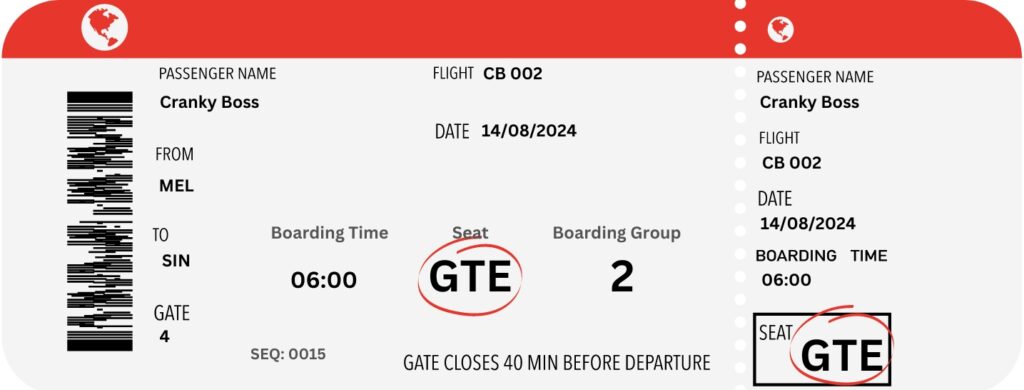When you’re getting ready to board a flight, one of the most important things you’ll need is your boarding pass. This little piece of paper or digital pass holds all the key details about your flight, like your seat number, gate information, and boarding time. Sometimes, though, you’ll notice strange abbreviations or codes on your boarding pass that might leave you scratching your head.
One of these codes is “GTE.” But what does “GTE” mean on a boarding pass?
“GTE” stands for “Gate Entry.” Let’s take a look at what that means.

Understanding Boarding Pass Codes
It’s helpful to understand that airlines use many codes on boarding passes to convey information quickly and efficiently. Some codes are simple and easy to understand, like “F” for First Class or “Y” for Economy Class. Others are more complex and might seem confusing at first glance. For example SBY on a boarding pass which stands for “standby”. Then there is the dreaded SSSS and then dealing with how to get rid of the ssss on your boarding pass.
The Meaning of GTE
The code “GTE” on a boarding pass stands for “Gate Entry.” This code indicates that the passenger will receive their seat assignment at the gate before boarding the plane. In other words, if you see GTE on your boarding pass, it means that your seat hasn’t been assigned yet, and you will need to check in at the gate to find out where you’ll be sitting. GTE is not the same as a waitlisted ticket.
Why Would a Boarding Pass Show GTE?
There are several reasons why a boarding pass might display GTE instead of an assigned seat number. Here are some common scenarios:
- Overbooked Flights: Airlines sometimes sell more tickets than there are seats on the plane, a practice known as overbooking. They do this because they expect some passengers won’t show up. If more people show up than expected, the airline may need to sort out seating at the gate. In this case, GTE is used as a temporary placeholder until the situation is resolved.
- Last-Minute Bookings: If you booked your flight at the last minute, there might not have been a seat available at the time of booking. The airline will assign you a seat at the gate once they know if there are any available seats.
- Special Seating Requests: If you’ve made a special seating request, like wanting a bulkhead seat or needing extra legroom, the airline might hold off on assigning your seat until you arrive at the gate. This ensures they can accommodate your request as best as possible.
- Flight Changes: If there was a change to your flight, such as switching to a different aircraft, the seating arrangements might be adjusted. In these cases, the airline may need to reassign seats at the gate.
What Should You Do if You See GTE?
Seeing GTE on your boarding pass might cause some anxiety, but there’s no need to worry. Here’s what you should do:
- Arrive Early: Since your seat hasn’t been assigned yet, it’s a good idea to arrive at the gate a bit earlier than usual. This will give you plenty of time to speak with the gate agent. This is especially important if you already suffer from travel anxiety.
- Check in Online: Check in online before arriving at the airport. This might help you get a seat assignment before you reach the gate, especially if seats open up closer to the flight time.
- Stay Calm: If your flight is overbooked, the airline will usually ask for volunteers to take a later flight in exchange for compensation. If you’re flexible with your travel plans, this could be an opportunity to get some extra perks.
- Be Ready to Board: Once you arrive at the gate, listen for announcements from the gate agent. They will call passengers with GTE on their boarding passes to come up and receive their seat assignments.
What Happens at the Gate?
When you arrive at the gate, the gate agent will typically call passengers with GTE on their boarding passes to come forward. They will then assign you a seat based on what’s available. This could be a middle seat, an aisle seat, or even an upgrade if you’re lucky!
In some cases, if the flight is fully booked and no seats are available, you might be asked to take a later flight. While this is rare, it can happen, especially during busy travel periods.
Tips for Handling GTE Situations
If you frequently travel or find yourself with a GTE boarding pass, here are some tips to make the experience smoother:
- Sign Up for Airline Alerts: Many airlines offer text or email alerts that can notify you of any changes to your flight, including seat assignments. This way, you can stay informed and plan accordingly.
- Join a Frequent Flyer Program: Frequent flyer members often receive priority when it comes to seat assignments, even in GTE situations. Joining these programs can increase your chances of getting a good seat.
- Be Polite to Gate Agents: Gate agents have a tough job, especially when dealing with overbooked flights. Being polite and understanding can go a long way in ensuring you get the best possible seat assignment.
- Consider Travel Insurance: If you’re worried about flight changes or cancellations, travel insurance can provide peace of mind. Some policies cover expenses related to delays or being bumped from a flight.
What’s the difference between GTE and SBY?
The codes “GTE” and “SBY” on a boarding pass both relate to seat assignments, but they have different meanings and implications. Here’s how they differ:
GTE (Gate Entry)
- Meaning: “GTE” stands for “Gate Entry,” which indicates that your seat has not been assigned yet and will be given to you at the gate before boarding.
- Reason: GTE is often used in situations where the airline needs to assign seats at the last minute. This could be due to overbooking, last-minute bookings, or special seating requests.
- Process: When you see GTE on your boarding pass, you should arrive at the gate early to get your seat assignment from the gate agent before boarding the plane.
- Outcome: GTE generally means you will get a seat on the flight, but the exact seat will be determined just before boarding.
SBY (Standby)
- Meaning: “SBY” stands for “Standby.” It indicates that you don’t have a confirmed seat on the flight and are on a waiting list for an available seat.
- Reason: SBY is used when the flight is fully booked, and you’re waiting for a seat to become available. This could happen if someone with a confirmed seat cancels or doesn’t show up.
- Process: If you’re on standby, you must wait at the gate to see if a seat opens up. Passengers are usually called in the order they were added to the standby list.
- Outcome: SBY carries more uncertainty than GTE. While GTE means you have a guaranteed seat (just not assigned yet), SBY means there’s a chance you might not get on the flight at all. If no seats become available, you may have to wait for the next flight.
Key Differences between SBY and GTE
- Seat Assignment: GTE indicates that you have a seat, but it will be assigned at the gate. SBY means you are waiting for a seat to become available and may not fly on that flight if no seats open up.
- Certainty: GTE provides more certainty that you’ll be on the flight, while SBY means your travel plans are less certain, and you might not get a seat.
- Priority: Passengers with GTE typically have priority over standby passengers (SBY) since they are confirmed on the flight but just waiting for a seat assignment.
In summary, GTE is about finalizing your seat at the gate, while SBY is about hoping a seat becomes available so you can board the flight.
Summing Up
Seeing GTE on your boarding pass might seem confusing at first, but it’s simply a code used by airlines when your seat assignment hasn’t been finalized. By arriving at the airport early, checking in online, and staying calm, you can handle this situation with ease. Whether due to overbooking, last-minute bookings, or special requests, GTE is just part of the airline’s process to ensure every passenger gets a seat.
So, next time you see GTE on your boarding pass, you’ll know exactly what it means and how to handle it.
And remember, never share your boarding pass online or your social media accounts as there is risks in doing so.
Safe travels!

